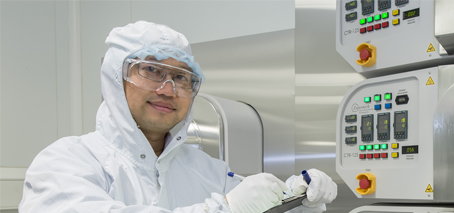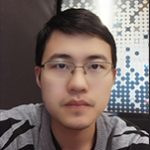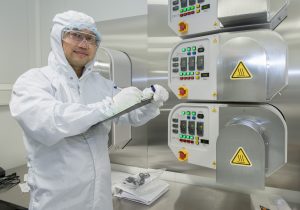“Endless” possibilities for custom nanotech design
FLEET’s research to achieve zero-dissipation electrical current depends on the design of key nanoscale structures.
Within FLEET, nano-device fabrication is coordinated via Enabling technology B, which links each of the research themes.
In 2017, Theme B leader Lan Wang, and PhD student Cheng Tan, developed a method to build such nanoscale structures, required to achieve zero-dissipation electrical current.
These nanostructures, comprising two stacked, 2D semiconductors, are key to FLEET’s Research theme 1 (topological materials) and Research theme 2 (exciton superfluids).
Bound together by van der Waals (vdW) forces, and comprising twin, disparate, atomically-thin layers, such structures are known as van der Waals heterostructures.
The new system, developed at RMIT, will enable the fabrication of a range of van de Waal structures, customised to realised room-temperature quantum anomalous Hall effect in Research theme 1 and twin-layer exciton superfluids in Research theme 2.
The ‘dry’ transfer system allows transfer and stacking of individual layers in an air-free ‘glove box’, so that air-sensitive materials can be used, and contaminants between the layers, such as water, are eliminated.
The method developed at RMIT allows the construction of numerous heterostructures, such as:
- Ferromagnetic material–topological insulator
- Ferromagnetic material–anti-ferromagnetic material
- Ferromagnetic material–ferroelectric material
- Superconductor–topological insulator.
“The possibilities for custom design are endless,” says Chief Investigator Lan Wang. “In 2018, FLEET’s RMIT team will collaborate with Centre colleagues at Monash University and UNSW to set up the required systems. Then it will be all systems go, fabricating all kinds of vdW devices for the FLEET team.”
“Realising room-temperature quantum anomalous Hall effect could carry really significant benefits for humanity,” says Lan. “It’s a relatively new field, so there are many discoveries to be made.”
“The science of topological matter , 2D materials, and vdW heterostructures are one of the newest, most-exciting fields in condensed matter physics. Graphene and topological phase of mater won Nobel Prize in 2010 and 2016, respectively. Other ground-breaking scientific discoveries have included quantum spin Hall effect, quantum anomalous Hall effect, Majorana and axion states in condensed matter system. And there will be many other discoveries to come! Besides the great interest in fundamental science, research in this field will also result in numerous industrial applications.”
For FLEET, such applications turn on the potential to use the ultra-low resistance paths resulting in such devices in future ultra-low energy electronics.
“In quantum anomalous Hall effect (QAHE) devices,” explains Cheng, “electron transport can occur without scattering, and without the need for an applied magnetic field or ultra-low temperature. This makes them ideal candidates for future low-energy devices.”
VdW heterostructure fabrication has never previously been performed in Australia.
FLEET’s Enabling technology B: nano-device fabrication
FLEET’s research sits at the very boundary of what is possible in condensed-matter physics. At the nano scale, nanofabrication of functioning devices will be key to the Centre’s success.
Specialised techniques are needed to integrate novel atomically-thin, two-dimensional (2D) materials into highquality, high-performance nano-devices.
For example, atomically-thin topological insulators will need to be integrated with electrical gates to realise topological transistors. And atomically-thin semiconductors must be integrated with optical cavities to realise exciton–polariton condensate devices.
Nano-device fabrication and characterisation links many of FLEET’s groups and nodes. Some groups bring expertise in device fabrication, while other groups are stronger in device characterisation. This teamwork is fundamental to modern science.
FLEET brings together Australian strength in micro- and nanofabrication with world-leading expertise in van der Waals heterostructure fabrication to build the capacity for advanced atomically-thin device fabrication.
Definitions
ferromagnetic materials These are materials in which electron spin can be aligned to form a strong magnetic field. Unpaired electron spins are lined up parallel to each other, resulting in an intense magnetic field, within a region of the bulk material. When a small magnetic field is applied, all the spins are 100% aligned, or parallel to, the field direction.
glove box Sealed container allowing manipulation within a controlled atmosphere via gloves
heterostructure A structure in which two dissimilar materials are brought together at a controlled interface
paramagnetic materials Materials that are attracted to magnetic fields and ferromagnets, but which are not magnetised. Materials in which electron spin are randomly distributed in the materials and can only be partially aligned, forming a weak magnetic field. When an magnetic field is applied, spins have a tendency to align parallel to field direction.
quantum spin Hall effect (QSHE) The spin-orbit interaction driven effect that gives a non-magnetic material conducting edges, which can carry current without resistance, as long as no magnetic disorder is present
quantum anomalous Hall effect (QAHE) A magnetic version of the QSHE (above), in which conducting edges carry currents in only one direction, and are completely without resistance
van der Waals (vdW) materials A material naturally made of 2D layers, held together by weak, electrostatic van der Waals forces




